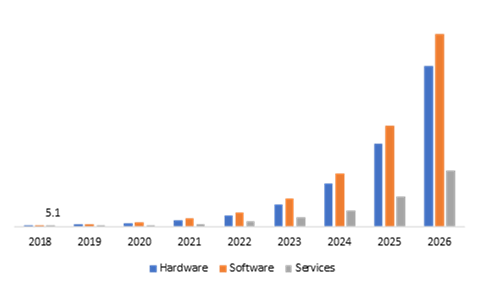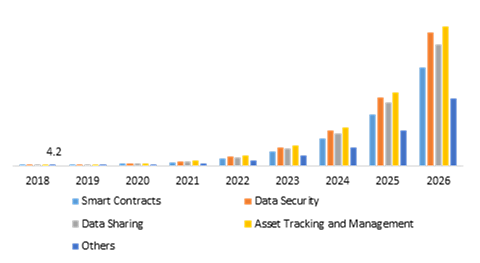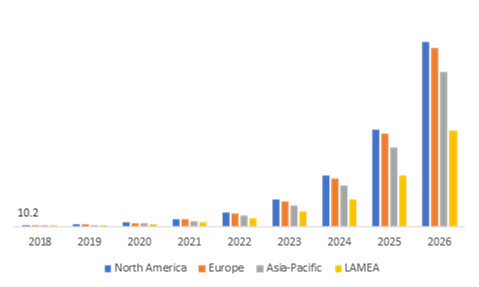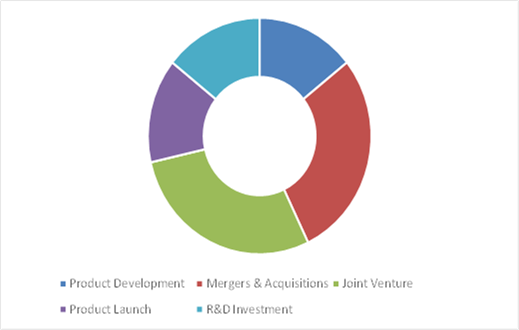Blockchain IoT Market Report
RA00045
Blockchain IoT Market, By Offerings (Hardware, Software, Services), By Application (Smart Contracts, Data Security, Data Sharing, Asset Tracking & Management), By End-use (Energy & Utility, Transportation & Logistics, Manufacturing, Building Management, Healthcare, Retail, Wearable & Mobile Devices, Smart Cities): Global Opportunity Analysis and Industry Forecast, 2019–2026
Update Available On-Demand
Global Blockchain IoT Market Insight and Outlook 2026
Global Blockchain IoT market size will reach $5,802.7 million by 2026, rising from $ 32.0 million in 2018, at a CAGR of 91.5%. Asia-Pacific Blockchain IoT market is anticipated to grow rapidly during the projected period, and is anticipated to reach $1459.8 million by the end of 2026, at a growth rate of 94.8%. This is majorly due to the rapid growth taking place in infrastructure and manufacturing sectors in various developing countries such as India, China and South Korea. The North America blockchain IoT market dominated the global blockchain IoT market in 2018. This region will witness market growth 90.1% and is anticipated to reach $1,746.5 million by 2026.
IoT is an advanced technology that connects all the devices over the Internet while blockchain is a type of distributed ledger technology. Collectively they form a secure analytical environment. Major benefits of utilizing blockchain for IoT are the least risks of collusion and tampering, reduced settlement and cost for transactions.
Blockchain IoT Market Drivers:
Blockchain IoT market is estimated to grow at a higher pace over the projected period, this is majorly due to the key factors such as raise in the implementation of IoT by various end-use industries. The growing necessity for IoT security and streamlining the business process across the world in order to improve work efficiency is another key factor that will upsurge the market growth in the near future. Additionally, the major growth prospects for the blockchain IoT market comprises of swift growth in the adoption of blockchain services for digital identity, rising government initiatives, and smart contracts.
In spite of the wide range of advantages, major factors affecting the market growth are the lack of awareness and acceptance of blockchain technology. Higher latency with a rise in the number of nodes and uncertain regulatory status possess the major challenges for market growth.
Blockchain IoT Market, by Offerings
The hardware segment is predicted to be most lucrative till the end of 2026

Source: Research Dive Analysis
The software segment in the blockchain IoT market was accounted for $15.4 million in the year 2018 and is expected to grow at a CAGR of 91.1% over the forecast period. However, hardware sub-segment is expected to register the highest growth rate over the forecast period growing at a CAGR of 93.6%. This is majorly due to the task performed by the hardware in the IoT systems, such as fetching the data from the source location and deliver it to the cloud systems where the required tasks are being performed.
Blockchain IoT Market, by Application
Smart Contracts segment is predicted to be most lucrative till the end of 2026

Source: Research Dive Analysis
The blockchain IoT is widely used for asset tracking and management in the application segment and accounted for the largest market value in the year 2018 for $8.3 million. Asset tracking and management plays a vital role in managing and tracking physical assets and also examining the performance of machinery on the manufacturing floor. Safety of physical assets for instance machinery, fleet and plants are the most important factors in the manufacturing sectors. The data security is further anticipated to grow at a higher CAGR of 93.4% over the forecast period, accounting for $1,377.9 million.
Blockchain IoT Market, by Mode of End-use
Smart Cities segment is predicted to be most lucrative till the end of 2026

Source: Research Dive Analysis
The energy and utility end-use segment held the largest market value in the year 2018, by accounting for $5.1 million. However, the smart cities' end-use segment is further expected to drive the market growth over the forecast period accounting for $639.4 million growing at a CAGR of 39.9% over the forecast period. Smart cities are adopting blockchain widely due to various advantages such as smart connectivity, which helps in tracking the data, provides undisruptive transactions and decreases the security breaches. The growing implementation of IoT in smart cities is expected to drive the blockchain IoT market in the near future.
Regional Growth of Blockchain IoT Market:
Asia-Pacific region will have enormous opportunities for the market investors to grow over the coming years

North America blockchain IoT market accounted for the largest market share in the year 2018. Whereas the Asia-Pacific market is expected to experience a swift growth over the forecast period, majorly due to the growing awareness among the people and increases in the adoption of IoT in various sectors such as healthcare, retail, and smart cities among others in the countries such as China and India.
Key participants in the Global Blockchain IoT Market:
Product development and joint ventures are the most common strategies followed by the market players

Source: Research Dive Analysis
Blockchain IoT market players include KrypC, Microsoft Corporation, Amazon.com, Inc., Intel Corporation, IBM Corporation, Cisco Systems, The Linux Foundation, R3, Filament, and Ethereum Foundation. These key players are majorly concentrating growth advancements in current technology, new product launches, mergers and acquisitions, and geographical expansion. These are some of the growth strategies adopted by these companies.
In October 2019, Microsoft launched Corda Enterprise, this blockchain service provides users with flexibility and choice in the usage of blockchain.
| Aspect | Particulars |
| Historical Market Estimations | 2016-2018 |
| Base Year for Market Estimation | 2018 |
| Forecast timeline for Market Projection | 2019-2026 |
| Geographical Scope | North America, Europe, Asia-Pacific, LAMEA |
| Segmentation by Offering |
|
| Segmentation by Application |
|
| Segmentation by End-use |
|
| Key Countries covered | U.S., Canada, Germany, France, Spain, Russia, Japan, China, India, South Korea, Australia, Brazil, and Saudi Arabia |
| Key Companies Profiled |
|
Q1. What is the size of the Blockchain IoT Market?
A. The global Blockchain IoT Market size was over $32 million in 2018, and is further anticipated to reach $5,802.7 million by 2026.
Q2. Who are the leading companies in the Blockchain IoT Market?
A. Microsoft Corporation, Inc. Amazon.Com and IBM Corporation are some of the key players in the global Blockchain IoT market.
Q3. Which region possesses greater investment opportunities in the coming future for Blockchain IoT Market?
A. The Asia Pacific possesses great investment opportunities for the investors to witness the most promising growth in the coming years.
Q4. What is the growth rate of the Asia Pacific Blockchain IoT Market?
A. Asia Pacific Blockchain IoT Market is projected to grow at 7.0% CAGR during the forecast period.
Q5. What are the strategies opted by the leading players in the Blockchain IoT market?
A. Product development and joint ventures are the key strategies opted by the operating companies in this market.
Q6. Which companies are investing more in R&D practices for Blockchain IoT Market?
A. IBM Corporation and Microsoft Corporation investing more in R&D activities for developing new products and technologies.
1. Research Methodology
1.1. Desk Research
1.2. Real time insights and validation
1.3. Forecast model
1.4. Assumptions and forecast parameters
1.4.1. Assumptions
1.4.2. Forecast parameters
1.5. Data sources
1.5.1. Primary
1.5.2. Secondary
2. Executive Summary
2.1. 360° summary
2.2. Offerings Type trends
2.3. Application trends
2.4. End-use trends
3. Market Overview
3.1. Market segmentation & definitions
3.2. key takeaways
3.2.1. Top investment pockets
3.2.2. Top winning strategies
3.3. Porter’s five forces analysis
3.3.1. Bargaining power of consumers
3.3.2. Bargaining power of suppliers
3.3.3. Threat of new entrants
3.3.4. Threat of substitutes
3.3.5. Competitive rivalry in the market
3.4. Market dynamics
3.4.1. Drivers
3.4.2. Restraints
3.4.3. Opportunities
3.5. Application landscape
3.6. Regulatory landscape
3.7. Patent landscape
3.8. Market value chain analysis
3.9. Strategic overview
4. Blockchain IoT Market, by Offerings Type
4.1. Hardware
4.1.1. Market size and forecast, by region, 2016-2026
4.1.2. Comparative market share analysis, 2018 & 2026
4.2. Software
4.2.1. Market size and forecast, by region, 2016-2026
4.2.2. Comparative market share analysis, 2018 & 2026
4.3. Services
4.3.1. Market size and forecast, by region, 2016-2026
4.3.2. Comparative market share analysis, 2018 & 2026
5. Blockchain IoT Market, by Application
5.1. Smart Contracts
5.1.1. Market size and forecast, by region, 2016-2026
5.1.2. Comparative market share analysis, 2018 & 2026
5.2. Data Security
5.2.1. Market size and forecast, by region, 2016-2026
5.2.2. Comparative market share analysis, 2018 & 2026
5.3. Data Sharing
5.3.1. Market size and forecast, by region, 2016-2026
5.3.2. Comparative market share analysis, 2018 & 2026
5.4. Asset Tracking and Management
5.4.1. Market size and forecast, by region, 2016-2026
5.4.2. Comparative market share analysis, 2018 & 2026
5.5. Others
5.5.1. Market size and forecast, by region, 2016-2026
5.5.2. Comparative market share analysis, 2018 & 2026
6. Blockchain IoT Market, by End-use
6.1. Energy & Utility
6.1.1. Market size and forecast, by region, 2016-2026
6.1.2. Comparative market share analysis, 2018 & 2026
6.2. Transportation & Logistics
6.2.1. Market size and forecast, by region, 2016-2026
6.2.2. Comparative market share analysis, 2018 & 2026
6.3. Manufacturing
6.3.1. Market size and forecast, by region, 2016-2026
6.3.2. Comparative market share analysis, 2018 & 2026
6.4. Building Management
6.4.1. Market size and forecast, by region, 2016-2026
6.4.2. Comparative market share analysis, 2018 & 2026
6.5. Healthcare
6.5.1. Market size and forecast, by region, 2016-2026
6.5.2. Comparative market share analysis, 2018 & 2026
6.6. Retail
6.6.1. Market size and forecast, by region, 2016-2026
6.6.2. Comparative market share analysis, 2018 & 2026
6.7. Wearable & Mobile Devices
6.7.1. Market size and forecast, by region, 2016-2026
6.7.2. Comparative market share analysis, 2018 & 2026
6.8. Smart City
6.8.1. Market size and forecast, by region, 2016-2026
6.8.2. Comparative market share analysis, 2018 & 2026
6.9. Others
6.9.1. Market size and forecast, by region, 2016-2026
6.9.2. Comparative market share analysis, 2018 & 2026
7. Blockchain IoT Market, by Region
7.1. North America
7.1.1. Market size and forecast, by Offerings, 2016-2026
7.1.2. Market size and forecast, by Application, 2016-2026
7.1.3. Market size and forecast, by end-use, 2016-2026
7.1.4. Market size and forecast, by country, 2016-2026
7.1.5. Comparative market share analysis, 2018 & 2026
7.1.6. U.S.
7.1.6.1. Market size and forecast, by Offerings, 2016-2026
7.1.6.2. Market size and forecast, by Application, 2016-2026
7.1.6.3. Market size and forecast, by end-use, 2016-2026
7.1.6.4. Comparative market share analysis, 2018 & 2026
7.1.7. Canada
7.1.7.1. Market size and forecast, by Offerings, 2016-2026
7.1.7.2. Market size and forecast, by Application, 2016-2026
7.1.7.3. Market size and forecast, by end-use, 2016-2026
7.1.7.4. Comparative market share analysis, 2018 & 2026
7.1.8. Mexico
7.1.8.1. Market size and forecast, by Offerings, 2016-2026
7.1.8.2. Market size and forecast, by Application, 2016-2026
7.1.8.3. Market size and forecast, by end-use, 2016-2026
7.1.8.4. Comparative market share analysis, 2018 & 2026
7.2. Europe
7.2.1. Market size and forecast, by Offerings, 2016-2026
7.2.2. Market size and forecast, by Application, 2016-2026
7.2.3. Market size and forecast, by end-use, 2016-2026
7.2.4. Market size and forecast, by country, 2016-2026
7.2.5. Comparative market share analysis, 2018 & 2026
7.2.6. UK
7.2.6.1. Market size and forecast, by Offerings, 2016-2026
7.2.6.2. Market size and forecast, by Application, 2016-2026
7.2.6.3. Market size and forecast, by end-use, 2016-2026
7.2.6.4. Comparative market share analysis, 2018 & 2026
7.2.7. Germany
7.2.7.1. Market size and forecast, by Offerings, 2016-2026
7.2.7.2. Market size and forecast, by Application, 2016-2026
7.2.7.3. Market size and forecast, by end-use, 2016-2026
7.2.7.4. Comparative market share analysis, 2018 & 2026
7.2.8. France
7.2.8.1. Market size and forecast, by Offerings, 2016-2026
7.2.8.2. Market size and forecast, by Application, 2016-2026
7.2.8.3. Market size and forecast, by end-use, 2016-2026
7.2.8.4. Comparative market share analysis, 2018 & 2026
7.2.9. Spain
7.2.9.1. Market size and forecast, by Offerings, 2016-2026
7.2.9.2. Market size and forecast, by Application, 2016-2026
7.2.9.3. Market size and forecast, by end-use, 2016-2026
7.2.9.4. Comparative market share analysis, 2018 & 2026
7.2.10. Italy
7.2.10.1. Market size and forecast, by Offerings, 2016-2026
7.2.10.2. Market size and forecast, by Application, 2016-2026
7.2.10.3. Market size and forecast, by end-use, 2016-2026
7.2.10.4. Comparative market share analysis, 2018 & 2026
7.2.11. Rest of Europe
7.2.11.1. Market size and forecast, by Offerings, 2016-2026
7.2.11.2. Market size and forecast, by Application, 2016-2026
7.2.11.3. Market size and forecast, by end-use, 2016-2026
7.2.11.4. Comparative market share analysis, 2018 & 2026
7.3. Asia-Pacific
7.3.1. Market size and forecast, by Offerings, 2016-2026
7.3.2. Market size and forecast, by Application, 2016-2026
7.3.3. Market size and forecast, by end-use, 2016-2026
7.3.4. Market size and forecast, by country, 2016-2026
7.3.5. Comparative market share analysis, 2018 & 2026
7.3.6. China
7.3.6.1. Market size and forecast, by Offerings, 2016-2026
7.3.6.2. Market size and forecast, by Application, 2016-2026
7.3.6.3. Market size and forecast, by end-use, 2016-2026
7.3.6.4. Comparative market share analysis, 2018 & 2026
7.3.7. Japan
7.3.7.1. Market size and forecast, by Offerings, 2016-2026
7.3.7.2. Market size and forecast, by Application, 2016-2026
7.3.7.3. Market size and forecast, by end-use, 2016-2026
7.3.7.4. Comparative market share analysis, 2018 & 2026
7.3.8. India
7.3.8.1. Market size and forecast, by Offerings, 2016-2026
7.3.8.2. Market size and forecast, by Application, 2016-2026
7.3.8.3. Market size and forecast, by end-use, 2016-2026
7.3.8.4. Comparative market share analysis, 2018 & 2026
7.3.9. Australia
7.3.9.1. Market size and forecast, by Offerings, 2016-2026
7.3.9.2. Market size and forecast, by Application, 2016-2026
7.3.9.3. Market size and forecast, by end-use, 2016-2026
7.3.9.4. Comparative market share analysis, 2018 & 2026
7.3.10. South Korea
7.3.10.1. Market size and forecast, by Offerings, 2016-2026
7.3.10.2. Market size and forecast, by Application, 2016-2026
7.3.10.3. Market size and forecast, by end-use, 2016-2026
7.3.10.4. Comparative market share analysis, 2018 & 2026
7.3.11. Rest of Asia-Pacific
7.3.11.1. Market size and forecast, by Offerings, 2016-2026
7.3.11.2. Market size and forecast, by Application, 2016-2026
7.3.11.3. Market size and forecast, by end-use, 2016-2026
7.3.11.4. Comparative market share analysis, 2018 & 2026
7.4. LAMEA
7.4.1. Market size and forecast, by Offerings, 2016-2026
7.4.2. Market size and forecast, by Application, 2016-2026
7.4.3. Market size and forecast, by end-use, 2016-2026
7.4.4. Market size and forecast, by country, 2016-2026
7.4.5. Comparative market share analysis, 2018 & 2026
7.4.6. Brazil
7.4.7. Market size and forecast, by Offerings, 2016-2026
7.4.8. Market size and forecast, by Application, 2016-2026
7.4.9. Market size and forecast, by end-use, 2016-2026
7.4.10. Comparative market share analysis, 2018 & 2026
7.4.11. Saudi Arabia
7.4.11.1. Market size and forecast, by Offerings, 2016-2026
7.4.11.2. Market size and forecast, by Application, 2016-2026
7.4.11.3. Market size and forecast, by end-use, 2016-2026
7.4.11.4. Comparative market share analysis, 2018 & 2026
7.4.12. South Africa
7.4.12.1. Market size and forecast, by Offerings, 2016-2026
7.4.12.2. Market size and forecast, by Application, 2016-2026
7.4.12.3. Market size and forecast, by end-use, 2016-2026
7.4.12.4. Comparative market share analysis, 2018 & 2026
7.4.13. Rest of LAMEA
7.4.13.1. Market size and forecast, by Offerings, 2016-2026
7.4.13.2. Market size and forecast, by Application, 2016-2026
7.4.13.3. Market size and forecast, by end-use, 2016-2026
7.4.13.4. Comparative market share analysis, 2018 & 2026
8. Company Profiles
8.1. Microsoft
8.1.1. Business overview
8.1.2. Financial performance
8.1.3. Offerings portfolio
8.1.4. Recent strategic moves & developments
8.1.5. SWOT analysis
8.2. Amazon
8.2.1. Business overview
8.2.2. Financial performance
8.2.3. Offerings portfolio
8.2.4. Recent strategic moves & developments
8.2.5. SWOT analysis
8.3. Ethereum Foundation
8.3.1. Business overview
8.3.2. Financial performance
8.3.3. Offerings portfolio
8.3.4. Recent strategic moves & developments
8.3.5. SWOT analysis
8.4. R3
8.4.1. Business overview
8.4.2. Financial performance
8.4.3. Offerings portfolio
8.4.4. Recent strategic moves & developments
8.4.5. SWOT analysis
8.5. KrypC
8.5.1. Business overview
8.5.2. Financial performance
8.5.3. Offerings portfolio
8.5.4. Recent strategic moves & developments
8.5.5. SWOT analysis
8.6. Factom
8.6.1. Business overview
8.6.2. Financial performance
8.6.3. Offerings portfolio
8.6.4. Recent strategic moves & developments
8.6.5. SWOT analysis
8.7. IBM
8.7.1. Business overview
8.7.2. Financial performance
8.7.3. Offerings portfolio
8.7.4. Recent strategic moves & developments
8.7.5. SWOT analysis
8.8. Intel
8.8.1. Business overview
8.8.2. Financial performance
8.8.3. Offerings portfolio
8.8.4. Recent strategic moves & developments
8.8.5. SWOT analysis
8.9. Cisco Systems
8.9.1. Business overview
8.9.2. Financial performance
8.9.3. Offerings portfolio
8.9.4. Recent strategic moves & developments
8.9.5. SWOT analysis
8.10. The Linux Foundation
8.10.1. Business overview
8.10.2. Financial performance
8.10.3. Offerings portfolio
8.10.4. Recent strategic moves & developments
8.10.5. SWOT analysis
8.11. Filament
8.11.1. Business overview
8.11.2. Financial performance
8.11.3. Offerings portfolio
8.11.4. Recent strategic moves & developments
8.11.5. SWOT analysis
8.12. IoTEX
8.12.1. Business overview
8.12.2. Financial performance
8.12.3. Offerings portfolio
8.12.4. Recent strategic moves & developments
8.12.5. SWOT analysis
Internet-of-Things (IoT) is booming. The world is changing by the revolutionizing innovations of technology. IoT is an advanced technology that connects all the devices over the Internet while blockchain is a type of distributed ledger technology. Collectively they form a secure analytical environment. It offers umpteen number of opportunities for industries to process smarter operations. While, on the other hand, Blockchain provides a scalable and decentralized system to IoT tools, applications, and platforms. Major benefits of utilizing blockchain for IoT are the least risks of collusion and tampering, reduced settlement and cost for transactions.
Drivers changing the Scenario of growth
Blockchain in IoT is impacting multiple industries. The rising adaptation of the blockchain in IoT in various industrial sectors has opened up a newer avenue for the blockchain in IoT market.
Logistics Industry
The current supply chain and logistics industry is facing challenges because of lack of transparency. The combination of Blockchain and IoT can provide great results by enhancing the traceability and reliability of the network.
Automotive Industry
IoT enabled vehicles with the decentralized network are more convenient for the multiple users as it allows them to exchange information in an easier and quicker way.
Smart Homes
The exchanging information generated by IoT devices can’t guarantee the security standards and ownership of data in the traditional centralized approach. With the help of the combined solution of Blockchain and IoT, the owners of smart homes can manage the security system of his home from the smartphone.
Pharmaceutical industry
The pharmaceutical sector has been witnessing the increasing incidents related to counterfeit medicines. Use of Blockchain IoT has enabled the pharmacy industry to counter this issue.
Food industry
Blockchain with IoT can redesign the food production industry. It can help the industry elevate throughout the journey starting from the farm to home.
The food supply chain can be enhanced to a greater extent by installing IoT sensors in the farms and transferring its data to the blockchain straightway.
Other factors
The growing necessity for IoT security and streamlining the business process across the world in order to improve work efficiency is another key factor that will upsurge the market growth in the near future.
The major growth prospects for the blockchain IoT market comprises of swift growth in the adoption of blockchain services for digital identity, rising government initiatives, and smart contracts.
Recent Developments- Mergers/Acquisitions
Product launches and acquirements are some of the key strategies opted by the industry leaders to preserve their position in the global or regional markets. According to a report by Research Dive , the major market players of blockchain in IoT include Microsoft Corporation, KrypC, Amazon.com Inc., IBM Corporation, Intel Corporation, Cisco Systems, R3, The Linux Foundation, Filament, and Ethereum Foundation. These key players’ focus is primarily on mergers and acquisitions, new product launches, the advancements in current technology, and geographical expansion. Some of the growth strategies utilized by these companies are enlisted below:
- In October 2019, Microsoft launched Corda Enterprise. This blockchain service provides users with flexibility and choice in the usage of blockchain.
- Infosys has announced launch of blockchain-powered distributed applications for insurance and supply chain management and government services domains in December 2019. These applications can be impeccably integrated with the existing systems and IoT devices. Moreover, this product will enhance the product portfolio as well as impact on the market size of the company.
- A latest report reveals that JP Morgan, the business giant is going to facilitate a merger of its in-house blockchain unit named Quorum with software developer ConsenSys based on Ethereum. The deal is presently going through negotiation process and is expected to be confirmed by the end of Q3 2020.
Personalize this research
- Triangulate with your own data
- Request your format and definition
- Get a deeper dive on a specific application, geography, customer or competitor
- + 1-888-961-4454 Toll - Free
- support@researchdive.com

